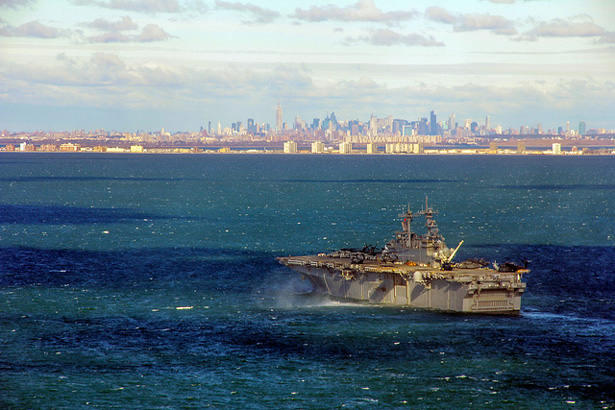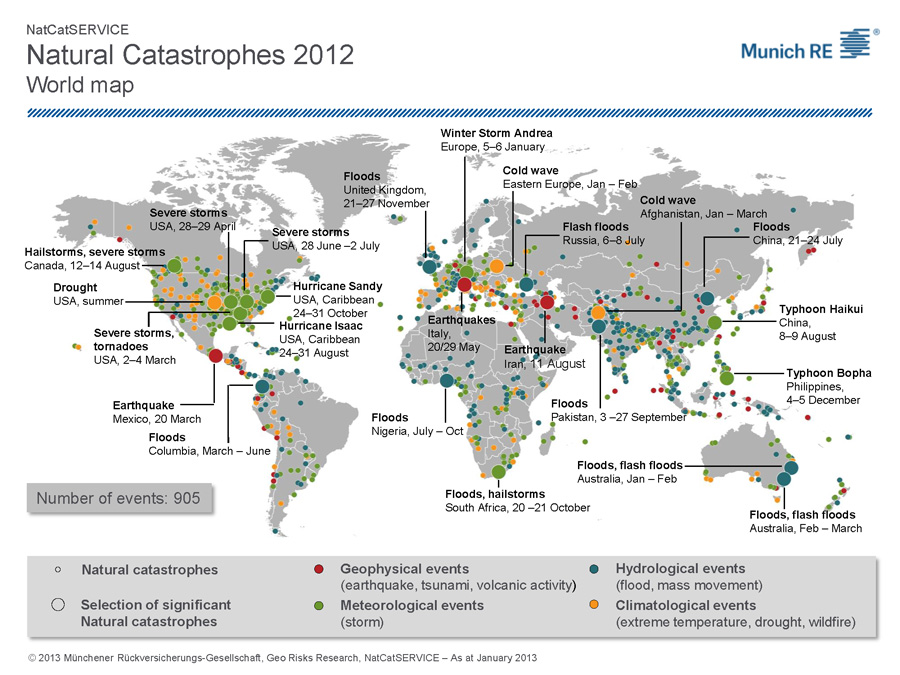-
Looking Back to Get Ahead: FEMA’s Strategic Foresight Initiative on Natural Disaster Preparedness
May 13, 2013 By Alan M. Wright
Natural disasters have dominated news coverage in the past several years, with many observers noting a distressing rise in the frequency and scale of disasters as well as rising costs. Despite these worrying trends, a critical mass of leadership and public support for doing something about it is emerging.
Last year’s record-setting weather helped crystallize the new reality of disaster impacts for many Americans. The United States suffered more than two-thirds of the world’s disaster damage from storms, drought, fire, and earthquakes, including the worst drought in a generation, freakishly strong thunderstorms, and the largest Arctic ice melt on record. And of course, Superstorm Sandy closed out the election year with a wake-up call: Such large-scale disasters in densely populated, coastal cities present a wickedly complex set of challenges.
The “New Normal”
Collectively, these mounting disaster risks expose us to a dangerous “new normal,” in which climate change is likely to sustain or worsen the scale of disasters. While events like Sandy offer “teachable moments” on managing the scale of future disasters, we’ll need more than lessons learned. We need concrete actions that drive truly forward-looking change.
 I believe we’re at a tipping point. It’s not just academics who are pushing for change; there’s greater public pressure on governments to adapt to the reality of the 21st century, embrace new ways of doing business, and better serve the needs of disaster survivors.
I believe we’re at a tipping point. It’s not just academics who are pushing for change; there’s greater public pressure on governments to adapt to the reality of the 21st century, embrace new ways of doing business, and better serve the needs of disaster survivors.The U.S. Federal Emergency Management Agency (FEMA) launched its Strategic Foresight Initiative (SFI) in 2010 as a transformative, community-wide effort to create an enduring foresight capability and catalyze the emergency management community to be prepared for whatever challenges and opportunities the future holds. The recent publication of SFI’s Toward More Resilient Futures showcases how the agency, as well as the entire disaster preparedness community, is taking real steps to promote greater resilience.
The report prompts us to think strategically about the future in three engaging and visually rich sections.
Scenario Building
First, the report draws from its scenario planning foundation to explore four dominant themes – the economy, environment, technology, and security – that will likely drive major changes over the next five years. What’s different about this report from other futures analysis is how it explores the trends that are leading indicators of change.
Each theme contains two competing storylines, placed side-by-side, that force readers to consider how the future may unfold along very different but interconnected paths. For example, the report explores what it means for disaster response and preparedness if America’s recent economic troubles are actually symptoms of an impending “great stagnation.” Or what the possibilities are if the rise of hyper-fast, mobile computing propel us into a new era of “technotopia.”
Crucially, the questions and implications of one storyline are weighed against the countervailing trends of a brighter or more challenging path. The report depicts the inherent messiness and complexity of the future, with all the pros, cons, and uncertainty we all deal with day-to-day. The bottom line: making these trade-offs won’t be easy, but we need to have a deeper discussion about these issues and how they may be used to improve U.S. resilience.
The SFI also provokes questions about how key trends, like big data, crowd-funding, and growing social inequality, will play out and affect resilience to disasters. Can we make practical use of crowd-funding platforms like Kickstarter and Neighbor.ly and inspire the do-it-yourself movement to apply their skills toward greater disaster resilience? Can the U.S. government foster greater trust and engagement through the internet while avoiding massive data breaches and respecting individual privacy? The report isn’t prescriptive about what actions to take to deal with these challenges and opportunities. Instead, it leaves us with the major implications and takeaways for government and emergency managers so that we can draw our own conclusions.
New Tools, New Success Stories
In the second feature, the report aims to make strategic foresight actionable by highlighting real-world applications of “foresight in practice.” These are organic efforts from the field that can perhaps serve as models for how to develop the capabilities, tools, and partnerships needed to manage future disaster risks.
Take Recovers.org as an example. In the wake of a tornado that hit their Massachusetts community in 2011, two sisters created an online platform that helps residents map their own neighborhoods and either request or offer assistance. The site has since grown to be used in more than a dozen large and small communities around the world (like the Lower East Side in New York City). Multiple organizations can collaborate, volunteers can sign up and release liability remotely, donors can list available resources rather than dropping them off, and those with needs can easily and privately request help from all relevant agencies at once. This gives emergency management a detailed view of preparedness levels across a given area and allows and encourages community members to help their neighbors efficiently. It’s precisely these sorts of tools and grassroots efforts that are at the forefront of improving resilience.
Tapping the Community’s Potential
Finally, the report asks public and private sector entrepreneurs to envision what disaster resilience might look like if we begin to drive change today.
Designer Michael McDaniel represents the voice of a new generation of entrepreneurs who are creating business ideas that also achieve social change. In the report, McDaniel outlines how innovative design work might spillover to government, resulting in transformations that affect emergency sheltering, communications, and power distribution.
Actively drawing on the ideas and talents of these pioneers outside traditional emergency management communities represents a key piece of the “whole community” approach that FEMA has recently championed. The underlying premise centers on the recognition that government-centric efforts cannot fully meet the challenges posed by disasters. And scattered throughout the whole community are many individuals who are innately innovative and interested in delivering better solutions that improve how we deal with disasters.
Despite the staggering toll taken by disasters over the last five years, I think there’s reason to be optimistic. And it’s captured in one of the taglines in Toward More Resilient Futures that I’ll paraphrase: Perhaps the biggest unknown we face in the future is not what will change, but how we’ll cope with emerging challenges and opportunities. The practice of strategic foresight – which helps us look back to better anticipate what’s ahead – can help us get there.
Alan M. Wright is a management consultant with Hassett Willis and Company. He’s consulted for FEMA since 2009 and supported the Strategic Foresight Initiative directly since it launched in 2010.
Sources: Bloomberg Businessweek, The Economist, Glen Burnie Patch, IDG News Service, Munich RE, The New York Times, Recovers.org, TEDx, U.S. Federal Emergency Management Agency.
Photo Credit: The USS Wasp positioned for Hurricane Sandy relief near New York City, courtesy of the U.S. Navy; Map: Munich RE/NatCatSERVICE. Video: TEDx.
 A Publication of the Stimson Center.
A Publication of the Stimson Center.




